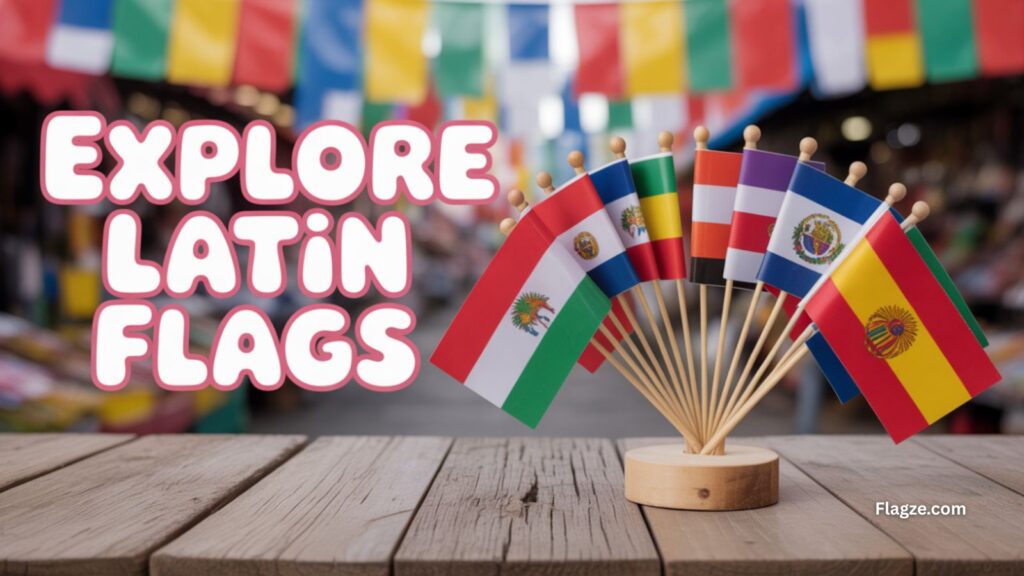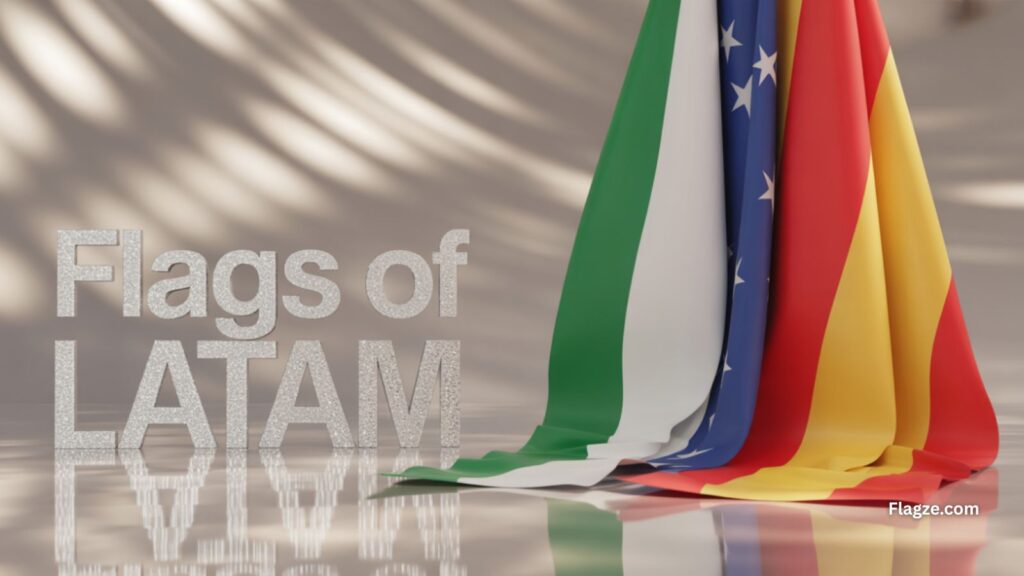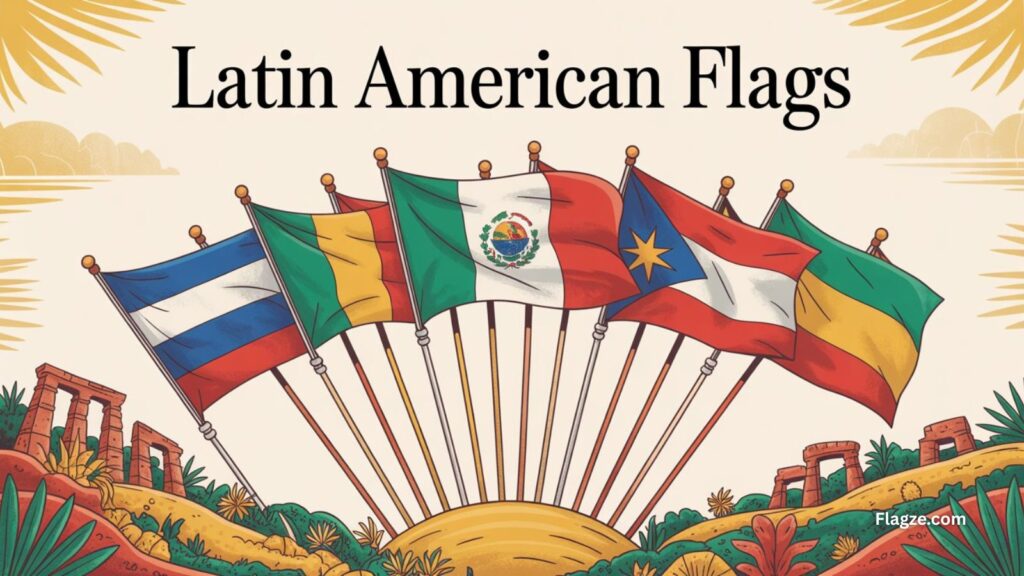Last Updated on August 18, 2025 by Adam Hussain
Latin American flags are more than just pieces of fabric. They represent history, culture, and the struggles of the region. Each flag holds a unique story about freedom, national pride, and the fight for independence. The colors and symbols tell us about the sacrifices made by the people of Latin America. These flags connect millions of people, offering a sense of unity and pride. From Mexico’s eagle to Brazil’s vibrant green, these flags serve as powerful symbols of national identity.

The Historical Journey of Latin American Flags
Latin American flags reflect the region’s journey toward independence. During the 19th century, countries like Mexico and Argentina fought hard to break free from colonial rule. Their flags emerged as symbols of rebellion and hope. These flags represented the desire for self-rule and unity during a time of great change.

Many of these flags carry symbols of strength and resilience. For example, Mexico’s flag features an eagle perched on a cactus with a snake in its beak, symbolizing the Aztec people’s connection to their homeland. Other countries, such as Argentina, adopted simple yet powerful designs that reflected their fight for freedom.
What Do the Colors and Symbols on Latin American Flags Represent?
The colors and symbols on Latin American flags have deep meanings. Each color represents a value or a historical event. For example, red often symbolizes the blood shed in the fight for independence. Blue and white often represent peace, loyalty, and freedom. The yellow in some flags, like Colombia’s, symbolizes the country’s wealth, including the gold that played a significant role in its history.

The symbols found on the flags also tell a story. Brazil’s flag, for instance, features a starry sky and the motto “Order and Progress.” These symbols represent Brazil’s ideals and its commitment to growth. Mexico’s eagle and snake reflect the country’s Aztec heritage and fighting spirit.
The Role of Latin American Flags in National Pride and Unity
Flags play a key role in national pride and unity. They are symbols that rally people during national holidays and celebrations. Whether it’s Independence Day or a major sports event, the flag reminds people of their shared history and values. In countries like Mexico, the flag is a source of pride that reflects the nation’s struggle for independence.

During global events, such as the World Cup or Copa América, Latin American flags are proudly displayed. The act of waving a flag brings people together. It strengthens the bond between citizens and represents the unity of the nation, no matter where they are in the world.
Famous Latin American Flags and Their Impact on Global Culture
Some Latin American flags are recognized worldwide. Brazil’s flag is one of the most iconic symbols, known for its green and yellow colors, which represent the country’s wealth and natural beauty. Mexico’s flag is another famous example, with its eagle and snake, symbolizing the country’s rich heritage and fighting spirit.

These flags not only serve as symbols of national pride but also influence how people around the world view Latin American countries. The colors, symbols, and histories behind these flags connect them to global events and media. Whether in sports, politics, or art, these flags have a far-reaching impact on how the world perceives Latin America.
The Future of Latin American Flags: Emblems of Progress and Change
As Latin American countries continue to evolve, so will their flags. Modern challenges and successes may inspire new symbols or slight changes in design. But the core values of freedom, unity, and independence will always remain central to these flags.

In the future, these flags will continue to unite people and inspire new generations. They will represent the progress these countries make as they move forward into a more globalized world, while always honoring their rich history and cultural heritage.
Conclusion
In conclusion, Latin American flags are much more than national symbols. They are representations of the region’s rich history, struggles, and cultural identity. Whether through their colors, symbols, or the stories they tell, these flags remind people of their shared heritage. They continue to be emblems of pride, unity, and progress for countries in Latin America and beyond.people who fought for freedom and independence. As national emblems, these flags continue to foster a sense of unity and pride among citizens and provide an important connection to the past, present, and future of Latin American countries.
FAQ’s
What is the Latino flag?
The term “Latino flag” is not associated with a single flag. Latin American flags refer to the flags of countries in Latin America, each representing the unique culture and history of the nation. These flags often share similarities in color and symbolism, reflecting their shared colonial past.
Why are Latin American flags similar?
Many Latin American flags share similar designs because they were influenced by the independence movements against colonial powers like Spain and Portugal. The use of red, blue, and white symbolizes the desire for freedom, unity, and independence, while stars and other symbols often represent national ideals.
What language is closest to Latin?
Spanish and Portuguese are the closest living languages to Latin, as they both evolved from the Romance languages that were derived from Latin. Spanish is spoken widely across Latin America, making it the most commonly spoken language in the region.
Are there 33 countries in Latin America?
Yes, there are 33 countries in Latin America, which include countries in both Central and South America as well as parts of the Caribbean. These nations share cultural ties and a historical legacy of Spanish and Portuguese colonization.



